
Worldcarblog.com
Shock discovery: The automatic braking system does not work when it is most needed
Most new vehicles sold in Europe and America are equipped with automatic emergency braking (AEB) as standard. However, new tests of the capabilities of this safety system have shown that it fails when it is most needed - at higher speeds.
Technology that uses radar, cameras or LiDAR to spot potentially dangerous situations has proven to be great at reducing the chance of rear-end collisions at lower speeds. However, problems arise at higher speeds, head-on collisions and at T intersections.
The American Automobile Association (AAA) tested the automatic emergency braking system in four vehicles (Ford, Honda, Chevrolet and Toyota) at higher speeds. AAA tested the systems in two scenarios at T intersections, with vehicles going straight through the intersection encountering an oncoming vehicle, and a vehicle turning left entering the path of an oncoming vehicle.
These are actually the deadliest types of traffic accidents in America, accounting for 39.2 percent of all deaths in two-vehicle crashes, and the emergency braking system test results were very modest.
At a speed of 46 km/h, AEB prevented a rear-end collision in 17 out of 20 test drives, i.e. in 85% of cases. For the test drives where the crash occurred, the vehicle's speed was reduced by 86%. On the other hand, at 62 km/h, this system prevented an accident in only 6 out of 20 test drives, or about 30% of cases. For the crash test runs, the speed was reduced by 62%.
However, the biggest debacle of this system occurred in tests at T intersections, where collisions occurred 100% of the time. The automatic emergency braking system did not manage to warn the driver, slow down the vehicle's speed or avoid a collision.
As the HAK Review writes, because of these results, AAA recommends that car manufacturers focus on creating systems that will perform better in crashes where injuries and deaths are most likely. In addition, drivers should be aware of the limitations of their vehicles, i.e. they should know that despite all safety systems, they must be maximally focused on traffic and react in time.
New car buyers trust Toyota
J.D. Power's 2022 Car Brand Loyalty Study has just been released, and among new car buyers, one brand stands out as a favorite.
Actually, there are four of them, but only one dominates the two categories of this established research. That brand is Toyota, although Ford recorded the highest percentage of loyal customers by a slight margin compared to the Japanese brand.
This study is now in its fourth year, and involves exclusively surveying new car buyers. In addition, it is focused on those people who practice shopping "old for new", staying true to the brand. Therefore, the survey includes only authorized sellers, using data from J.D. Power's news networks. There is good demand for used cars at the moment, but this study provides an interesting insight into the loyalty of customers who are patient enough to wait for the delivery of their new tin pet, given that stocks are reduced.
Toyota has quite a loyal following. The Japanese manufacturer is ranked in the leading position in the category of mass-produced cars and SUVs/crossovers, achieving a loyalty rate of 62.2 percent for passenger vehicles and 63.6 percent when it comes to SUVs/crossovers.
Of course, premium brands are also ranked, and among them are the leading Porsche with 57.4 percent, i.e. BMW, which reigns in the SUV/crossover class with 58.6 percent. Pickup trucks are the final category in the survey and it is naturally dominated by Ford, whose loyalty rate is 63.8 percent, which is slightly better than Toyota in terms of the best result.
"There are many ways to cultivate customer loyalty, but each winning brand demonstrated a commitment to fresh product launches, great processes focused on vehicle owners, great residual value and an attractive offering," said VP J.D. Data and Analytics Power, Tyson Jomini. "And they're the ones who are winning the most in terms of market share."
In the premium segment, Genesis in the car category (54.6 percent) and Lexus in the SUV/crossover class (56.4 percent) also rank well. Second place among mass-produced manufacturers went to Kia (54.1 percent) and Subaru for SUVs/crossovers (62.6 percent). Toyota almost didn't get the third title, finishing behind Ford in the pick-up truck category with 58.7 percent.
2023 BMW M4 CSL Is Not for the Faint of Heart
This ultimate M car is BMW's answer to the Porsche 911 GT3 and the upcoming Mercedes-AMG C63 S E-Performance.
At an indicated 274 km/h (170 mph) on the Autobahn A94 Munich-Passau in the 2023 BMW M4 CSL, we muster the last crumbs of courage and stretch out the right foot all the way. Guess what happens? The thing downshifts into seventh. At a ludicrous 5800 rpm, a token 1400 rpm below the redline—ignoring the danger to the driver's ancient heart. At 300 km/h sharp (186 mph), it upshifts into eighth again, still accelerating, but now with the digital speed readout increasing by 1 km/h at a time. (It’s 5:30 a.m., and there's no traffic in sight, so the relative risk is at its lowest.) Theoretically, this ultimate M car is capped at 191 mph. But what looked at first like a barely noticeable kink up ahead in the freeway suddenly felt like A Very Serious Corner. "Never lift"? T-shirts rarely tell the true story, but the rearview mirror always does. And it showed the driver grinning from ear to ear.
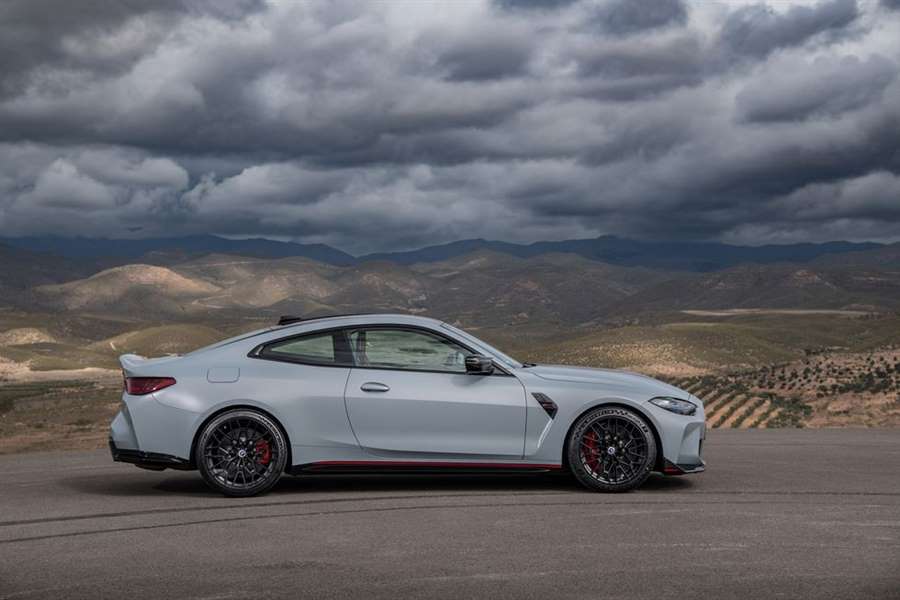
The M4 CSL is BMW's answer to the Porsche 911 GT3 and the upcoming Mercedes-AMG C63 S E-Performance. Like the hardest-core 911s, this BMW is strictly rear-wheel drive, and it shows, especially in the wet with Michelin Cup 2 R tires, which should only be legal in sunshine states, not in Bavaria. Compared to this beast, every other M4 is a kitten. For a start, the CSL is a claimed 190 pounds lighter than the base model. You can feel the weight savings, and you can also hear it. Stripped of its back seat, the rear compartment has mutated into a giant boom box. Some 24 pounds of removed sound-deadening material exacerbate the acoustic assault, with the carbon-fiber roof capping the resonance chamber, and the titanium exhaust designed to raise goosebumps. A whopping 53 pounds were saved by replacing the standard seats with carbon-fiber screw-clamps billed as sports buckets. Upping the pain coefficient of the seats is the lowered and stiffened suspension.
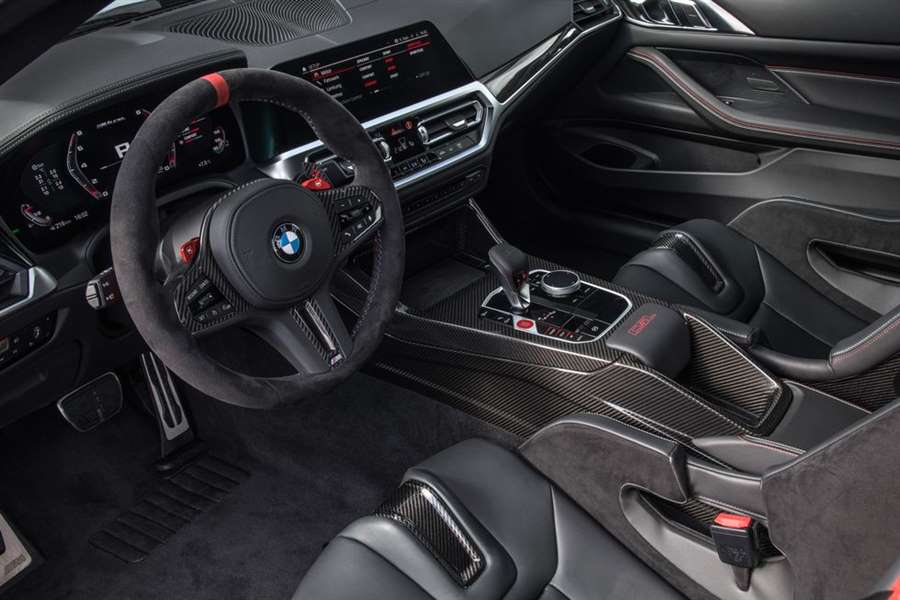
The first 20 miles are an I-hate-this-car experience. The 275/35ZR-19 and 285/30ZR-20 tires wriggle along like a quartet of eels. The dampers in Sport Plus are devoted wholly to shock, not absorption. The steering is initially too light to be trusted. And every blip of the throttle strikes your nervous system like lightning. You never relax in the M4 CSL, but the initial angst eventually does recede as curiosity replaces it, followed by the first bouts of let's call it confidence. In Sport, with tire temperatures at last where they should be, we finally dare to dive into the car's deep talent pool and snorkel for all the revelations it harbors. Like more cornering grip than a gallon of Loctite and more poise than such a zero-tolerance setup should be allowed to muster.
The CSL engine is the ultimate variation of the M division’s 3.0-liter twin-turbo straight-six. Its output is boosted from the base model's 473 horsepower and 406 pound-feet to 543 horsepower and 479 pound-feet. That's the good news. The bad news is the money thing. At a starting price of $140,895, one could buy two base M4s for the cost of a CSL with a few options. And BMW has closed the order books even before the first of the 1000 limited-edition models was delivered to a customer. Scarcity alone should make the striped-and-winged lightweight special an instant blue-chip investment—but is it? Although the CSL is exceptionally involving and outright faster than its siblings by some margin, our estimated zero-to-60 time of 3.3 seconds is eclipsed by the comparatively inconspicuous M4 Competition xDrive, which may be down 40 horsepower but has the same torque and hits 60 in 2.8 seconds, all for about $60K less.
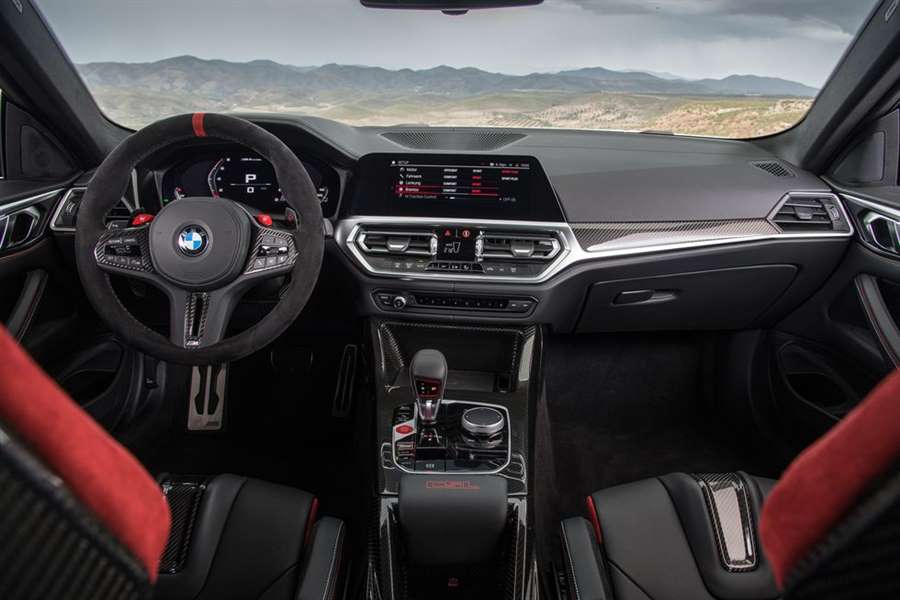
After just over 200 miles, we had to pit for fuel. The mileage? An OPEC-friendly 12 mpg. But what the hell? It finally stopped raining, and the winding route back to Munich promised a familiar Garden of Eden dotted with twisties and free of radar traps. Time to forget the tame preset M1 program and dial in the devil's own M2 composition instead. The preferred algorithm looked like this: engine in Sport Plus, gearbox in the S3 quick-shift setting, chassis in Comfort (compliance is control), DSC in MDM (M Dynamic Mode), steering and brakes in Sport.
Despite certain NVH conspicuities, the CSL drivetrain epitomizes absolute seamlessness. Hard acceleration brutality beams you through time and space, accompanied by a howling, growling, barely filtered soundtrack. The initially explosive, then increasingly progressive forward thrust has its antidote in the simply stupefying carbon-ceramic brakes. There's no doubt about it: This car makes your eyes pop out in one take only to flatten the earlobes in the next. It quite simply redefines the Ultimate Driving Machine.
Source: caranddriver.com
An even more powerful BMW XM with 748 HP is coming
BMW has released the first photo of the exclusive Label Red version of the new XM model.
Label Red will make the XM the most powerful hybrid crossover on the market. As the nameplate says, the car will be recognizable by its matte black paint and plenty of red accents that aren't available on the standard BMW XM variant.
BMW has also equipped the XM Label Red with distinctive wheels that combine gloss black spokes with bright red accents.
A photo of the interior is not yet available, but the German manufacturer says that the red and black color combination extends to the interior, along with specific decorative details.
Although BMW has not released all the technical details of the Label Red version, it has been confirmed that the drive system will be improved compared to the regular model, which has 653 hp (480 kW) and 800 Nm.
Thus, this exclusive will have a hybrid drive that produces as much as 748 HP (550 kW) and 997 Nm of maximum torque. Accordingly, better performance compared to the standard version and its 0-100 km/h acceleration of 4.3 s are expected.
The BMW XM Label Red will premiere in 2023, when we will have more information about this car.
Mazda is leaving Russia
Asian media reports that Mazda will sell its stake in the Russian joint venture to local carmaker Sollers.
The Japanese automaker has been looking for ways to wind down its Russian operations since the invasion of Ukraine in February. In March, they confirmed that the export of parts to the Vladivostok factory would end and that production would cease when these stocks were used up. The factory produced around 29,000 vehicles in 2021, Nikkei Asia reminds.
According to media reports, Sollers is currently negotiating with Mazda to buy out its share in the joint venture.
"Sollers Auto has already developed a plan to restart the plant for the production of other car brands and negotiations on this matter are currently being concluded," Sollers confirmed in a statement.
Mazda's move to leave Russia comes shortly after Toyota confirmed it was also pulling out of its Russian operations. Toyota highlighted difficulties in obtaining parts and the need to compensate workers, stating that there is no prospect of resuming production in the near future due to the parts shortage.
Volvo XC40 review
The Volvo XC40 is a comfortable and stylish small SUV that has some pleasing practical touches and a lot of Swedish cool
Verdict
The Volvo XC40 is a strong contender in the market for small premium SUVs. It’s not a revelation on the road, but it strikes a decent blend of comfort and cruising refinement, and offers premium SUV appeal in a small-car package. This allows passengers to enjoy the funky, minimalist cabin and the capable infotainment system.
Factor in competitive pricing when compared to rivals, as well as Volvo's traditional focus on safety, and you’re left with one of the most appealing offerings on the market. That's why we made the XC40 our Small Premium SUV of the Year in our 2018 New Car Awards.
About the Volvo XC40
Introduced in 2017, the Volvo XC40 is a mid-sized premium SUV that majors on practicality and comfort while offering bold styling that helps set it apart from its more conservative rivals. Its great safety rating and suite of available active safety systems will appeal to customers, too.
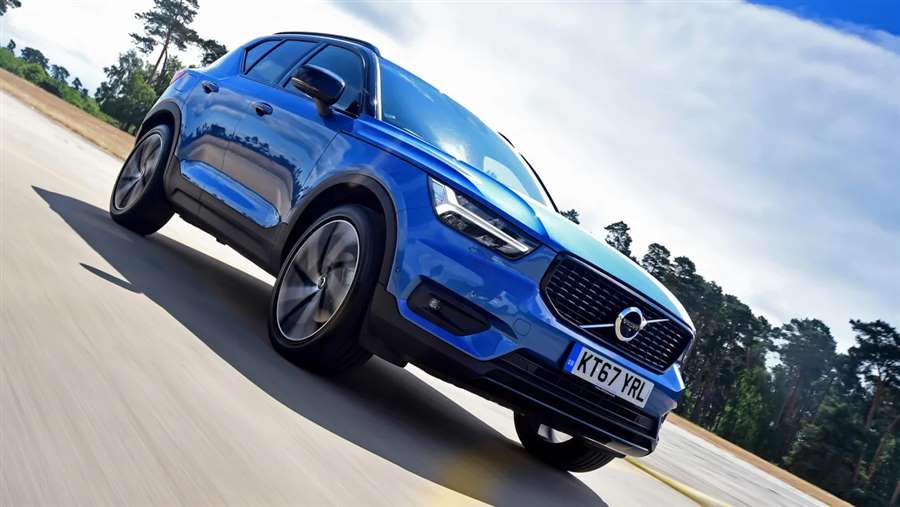
n terms of size and price, the XC40 slots into the Volvo SUV range below the XC60 and XC90, and is offered in Core, Plus and Ultimate trims.
There's a similar engine range too, and the XC40 receives the latest mild-hybrid ‘B’ engines from its bigger siblings. You can also buy plug-in hybrid and fully electric versions. Volvo aims to launch a fully electric car every year, as it seeks to make all-electric cars 50 per cent of global sales by 2025, with the rest hybrids. Recharge will be the overarching name for all chargeable Volvos with a fully electric and plug-in hybrid powertrain.
Rivals for the Volvo XC40 include the BMW X1 and X2 duo, the Jaguar E-Pace, Land Rover Discovery Sport, Range Rover Evoque, Audi Q2 and Q3 and Mini Countryman.
Where the XC40 stands out is with its fresh looks. The chunky lines define it as an SUV, yet its compact dimensions mean it's no more manageable than a compact hatchback.
Inside, the XC40 focuses on style, with a design-led interior that uses digital displays and quality materials to create an upmarket cabin which can be upgraded with a variety of individual options. Power comes from a range of three and four-cylinder petrol engines, along with B-badged mild-hybrid petrol versions.
The range kicks off with a B3-badged 161bhp petrol, then a 194bhp B4, while the 247bhp four-cylinder B5 is no longer available. The B3 is front-wheel drive and every version gets an eight-speed automatic as standard, while the B4 is offered with front- or all-wheel-drive.
The 208bhp Recharge T4 and the 258bhp Recharge T5 plug-in hybrids stick to front-wheel drive and an automatic gearbox, while Volvo has also introduced the XC40 P8 pure electric model with all-wheel-drive and 402bhp, along with a 228bhp all-electric Single Motor version.
Volvo previously matched a basic Start trim with the lower-powered 1.5-litre T2 petrol engine to create a single entry-level model, but this is no longer available. There are now three main trim levels – Core, Plus and Ultimate, which offer lots of kit as standard.
The Core model is well catered for, although there is a significant asking price of around £35,000. It comes with dual-zone climate control, 18-inch wheels, rear parking sensors, a powered boot, auto-folding door mirrors, cruise control and digital instruments all included. Also on board is Volvo’s excellent nine-inch portrait-layout infotainment system.
Plus adds extra kit such as a rear-view camera, keyless entry, a hands-free opening boot, heated front seats, a heated steering wheel and even a heated windscreen.
Ultimate is the plushest XC40, bringing a 12-speaker Harman Kardon stereo system, panoramic sunroof, adaptive Pixel LED headlights and a 360-degree camera view.
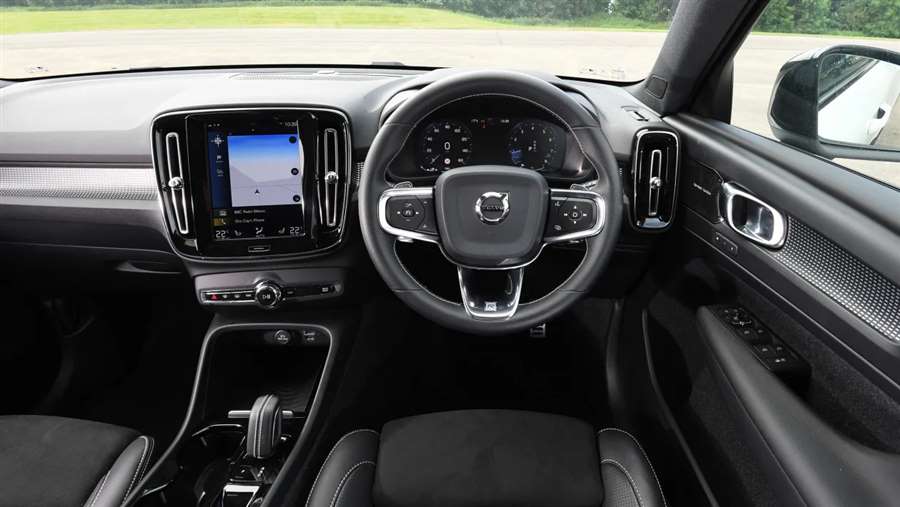
Volvo XC40 review - Engines, performance and drive
The XC40 majors on comfort and refinement instead of driving entertainment, and it does so rather well
The XC90 and XC60 are both based on Volvo’s Scalable Product Architecture (SPA) platform, but the XC40 is the first model from the Swedish brand to sit on the Compact Modular Architecture (CMA) underpinnings. This uses MacPherson strut suspension at the front and a multi-link rear axle, which means the new Volvo matches its German rivals for chassis technology under the skin. However, if you’re looking for dynamic sparkle and hot hatchback-rivalling agility down a country road, you’ll be better off elsewhere.
For everyone else, though, the XC40 strikes a nice balance between composure and comfort. It can get caught out on pockmarked city streets, particularly at low speeds and on the optional larger wheels - but provided you stick with the original items, you’re likely to find the baby Volvo a pretty relaxing place to spend time. This isn’t just down to ride quality, of course, because the engines do a good job of fading into the background too.
The engine does its best work between 1,500rpm and 3,000rpm, and the eight-speed auto is keen to shift up just before the higher of those figures. It’s nicely judged, really, because that’s also the point where the motor really identifies itself as a diesel, through a harsher note and increased volume.
It’s worth remembering, though, that should you want to get more involved in the gearshifting process, not every version is available with steering wheel-mounted shift paddles. And this restriction is compounded by the fact that the stubby gear selector between the front seats actually has a lateral shift pattern - pull it towards the driver to shift down, and push it towards the passenger to shift up. It’s a bizarre layout that will take even the most adaptable of drivers a long time to get used to.
Even on those optional wheels, at high speeds the XC40 does a good job of soaking up road imperfections. You’ll occasionally notice a slight floating effect, but it never strays to the point of making you seasick. Its trickiest moments come at low speeds around town, where you might find the car troubled by deep potholes. Then again, we’d expect a standard Momentum on 18-inch wheels to demonstrate a bit more compliance in this regard.
It wouldn’t be unreasonable to expect such a generally wafty small SUV to be boat-like in corners, but in fact, the XC40 stays composed, even when required to perform a sudden, rapid change of direction. The steering adds to the experience - not because it’s blessed with any great deal of feedback, but rather because it’s nicely weighted and pleasingly direct. Playing around with the car’s Drive Mode selector and switching it into Dynamic actually has a negative effect, in fact, because it adds heft to the steering instead of any discernible extra communication.
Ultimate models fitted with 19-inch alloy wheels feel firm on typically torn UK roads. The chassis deals with more flowing undulations well, but sharper bumps shock the chassis, whereas a BMW X1 smothers imperfections a little more adeptly.
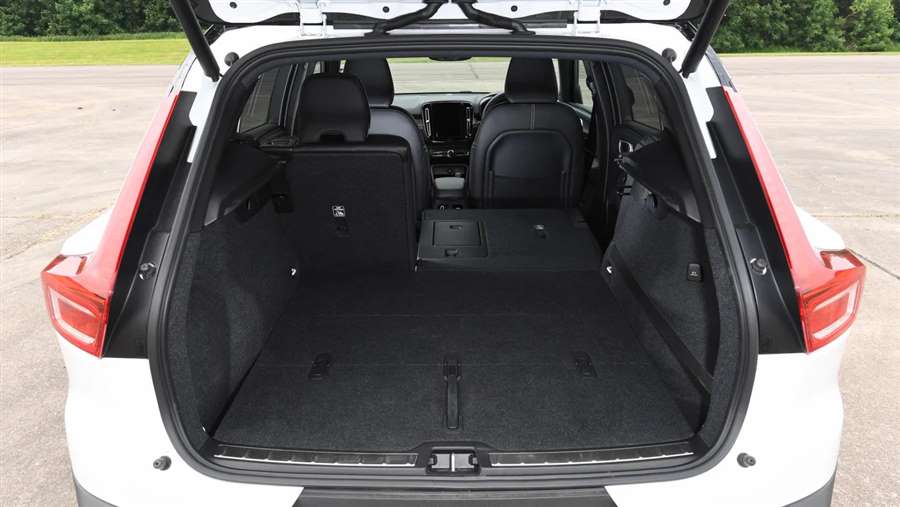
However, light steering and a well-judged chassis set-up means that the Volvo does at least respond well to inputs. It’s not as involving or as quick to change direction as the BMW, but for a tall SUV with a relatively short wheelbase, it offers a decent level of composure.
The XC40 has a mix of full electric, hybrid and turbocharged petrol engine options – with some petrol models having been refreshed in 2019 to offer more power and improved economy. The range starts with the mild-hybrid B3 four-cylinder petrol, producing 161bhp with a seven-speed automatic gearboxes. All B3 models are front-wheel drive.
Step up to the B4 with 194bhp and an automatic gearbox also comes as standard, but there's the choice of front- or four-wheel drive.
The 258bhp Recharge plug-in hybrid T5 model is powered by a 1.5-litre three-cylinder mated to an electric motor. It’s an impressive unit – with all that battery assistance, the three-cylinder motor feels like it lives a relatively unstrained life, but it’s capable of a proper turn of pace. Volvo’s claimed 7.3-second 0-62mph time points to solid performance, owing to the strong reserves of torque the XC40 Recharge can muster, and it does it with so much refinement too.
The cheaper Recharge T4 plug-in hybrid version produces 208bhp and gives away 1.2 seconds to its more powerful sibling in the sprint to 62mph.
Volvo has also added the 402bhp P8 pure electric Recharge model to the range. It makes use of two electric motors powered by a 78kWh battery and is capable of 0-62mph in a claimed 4.9 seconds. The 228bhp Single Motor version (with a 69kWh battery) needs a more leisurely 7.4 seconds to complete the benchmark sprint.
Volvo XC40 review - MPG, CO2 and running costs
Ballpark fuel efficiency, with respectable CO2, but the real gains come with the Recharge plug-in hybrid and pure-electric versions
The XC40’s engine line-up comprises state-of-the-art motors, with a wide range of electric, hybrid and petrol units. The efficiency figures on the XC40 are respectable for the class, but no better than that.
The cleanest XC40 models are the Recharge P8 pure electric and Single Motor which emit 0g/km. Next up are the Recharge T4 and T5 plug-in hybrid models which emit 47-49g/km, depending on chosen specification.
As you might expect, the standard petrol XC40 takes a hit on fuel efficiency and CO2 emissions; at 152g/km for the B3, it's probably a big enough tax hit for lots of company car choosers to overlook it. In reality, it’s a very thirsty unit, too - we struggled to get mid-thirties mpg out of the B3 in our time behind the wheel. The front-wheel drive B4 with mild-hybrid tech offers greater performance than the B3, and the same returns in real world economy.
Insurance groups
Insurance groups for the XC40 range from Group 18 to Group 32. On a like-for-like basis, the Volvo is ranked slightly lower than its German rivals - not least helped because of the Swedish brand’s reputation for passive and active safety systems.
Depreciation
Volvo is currently on the crest of wave in terms of customer demand, and when you also factor in the strong desirability within the premium SUV market, it's no surprise that the XC40 has strong residual values; 53 per cent for the all-electric models, and 57-62 per cent for mild-hybrid petrol and plug-in hybrid models.
Volvo XC40 review - Interior, design and technology
Bags of Swedish cool, with a clean, uncluttered design that still manages to incorporate some lovely practical touches
Volvo has deliberately moved the XC40 away from the more luxurious, grown-up presence offered by the larger XC60 and XC90 models – but that doesn’t mean there’s no scope for impressive design touches or the latest technology. Quite the opposite, in fact, because the baby Volvo brings something new to the premium small SUV market.
The car’s styling was inspired by small robots that the British designer, Ian Kettle, saw in science-fiction movies. The end result is lots of simple, clean, resolved lines - and a look that manages to look chunky and cute at the same time. It’s helped by a further evolution of Volvo’s ‘Thor’s Hammer’ headlight motif at the front end.
There’s more scope for personalisation than on the XC60 and XC90 too, thanks to contrast roof colours on some versions (black or white, depending on the trim level).
Inside, there’s not a great deal in the way of opulence - and yet the XC40 still manages to deliver a dose of Swedish cool, much in the same way as a well-resolved IKEA living room display. There’s remarkably little clutter and although the actual amount of space isn’t any greater than the class average, the Volvo’s plethora of neat practical touches makes the XC40 feel a lot more ‘real-world liveable’ than many of its rivals.
Technology helps with this too, of course. And in this respect, a slice of shameless carryover from the XC60 and XC90 works wonders – because the XC40 gets the same nine-inch portrait-layout infotainment display as its larger brothers, as well as a 12.3in digital instrument panel instead of conventional dials. These are standard across the range, too.
Sat-nav, stereo and infotainment
The XC40 uses a new Android-based operating system with built-in online Google services. It’s still displayed on a nine-inch portrait-oriented display, but the graphics are sharper and the shortcut keys bolder and less fiddly to use than previous Volvo set-ups – although they are still on the small side.
Loading times are good, however; the process from typing an address to the system loading the first navigation instruction took just 18 seconds, and Google’s live traffic info means the route and time to destination will be accurate, too.
There’s only one physical control; a single button below the screen takes you back to the home page, and the air-con settings are adjusted through the screen. For a first-time user, the set-up takes a little getting used to, but it’s hard to fault if you link it to a Google account.
Volvo XC40 review - Practicality, comfort and boot space
A well-judged amount of cabin space and some neat features to help maximise boot space make the XC40 more than practical enough
The XC40 enters a class where style and image have traditionally been more important than genuine space. But while the Volvo doesn’t deliver an aircraft hangar’s worth of room in the cabin, it manages to do enough to stand out from the crowd.
The XC40’s interior is neat, functional and, in its own way, very Swedish. If you’re absolutely set on having soft-touch fabrics and squishy plastic on the dashboard then you’ll probably judge it a disappointment, but the rest of us should find the interior a pretty special place to spend time.
The facia has relatively few switches, and a clean, uncluttered look. And depending on the trim you choose, and your bravery with the options list, there’ll be a vibrant flock lining in the enormous door bins to offer a dash of funky colour. The capacity of these door cubbies is huge, in fact - helped by Volvo’s decision to move the speakers out of their traditional area and arrange a sound system based around the top of the dashboard instead.
There are plenty of simple, clever touches, too. You’ll find a folding hook integrated into the glovebox that is designed to help you make it home without spilling a drop of your chicken chow mein. The rather flimsy-looking lidded compartment between the front seats turns out to be a removable, washable bin. And there’s also the option of a wireless phone charging pad and USB port at the base of the centre console.
A lengthy wheelbase helps with rear legroom - although the amount of headroom for back-seat passengers is equally impressive, even with the optional panoramic sunroof fitted. There’s plenty of room on board for four grown-ups, although a fifth adult may complain about the high transmission tunnel.
The boot isn’t the largest in the class, but the floor is commendably flat and there are some clever (optional) dividers that help to stop your shopping from rolling around when you’re on the move.
The Volvo XC40 is 4,425mm long, 1,863mm wide and 1,658mm tall. That makes it a little shorter than the BMW X1, but longer than an Audi Q3 - and it’s notably wider and taller than both of those rivals, too.
Leg room, head room & passenger space
Expect the XC40 to provide a cavernous cabin and you’ll be disappointed. But what the Volvo does do is maximise the potential of what space is on offer.
There’s plenty of space for two adults up front, and you’ll be able to fit a couple of grown-ups in the back seats easily too. The XC40 has a pretty long wheelbase, so they should be fine for legroom - and the amount of headroom for back-seat passengers is equally as impressive, even with the optional panoramic sunroof fitted.
Can you squeeze a third person into the rear seats? Yes, at a push. But there’s a transmission tunnel running down the middle of the floor, so they may complain about having to place their feet at either side of it.
Boot
The XC40 doesn’t boast the largest load bay in its class, but it’s easy to use what space is on offer there. That’s because the 452-litre boot has an impressively flat floor, with no lip at the front edge, so it’s easy to slide heavier items in there.
Spec the Convenience Pack and you’ll get a folding boot floor that can divide the space and stop your shopping from rolling around. The hinges even stand proud of the top edge of the resulting divider, giving you a few extra points from which to hang shopping bags.
Customers won't be short of room if they opt for one of the Recharge models, either. These cars include batteries that line the car’s spine, which crucially leaves the standard boot space unaffected. Due to the lack of an internal combustion engine, the Recharge P8 pure electric version also has an extra 30-litre storage bin under the bonnet.
Towing
The all-electric XC40 Recharge Single Motor is rated to tow up to 1,500kg, while the T4 and T5 plug-in hybrid models are both able to pull 1,800kg. The B3 petrol splits the difference with a 1,600kg maximum braked trailer weight, while buyers prioritising towing ability will be better served by the B4 version which has a 2,000kg limit in front-wheel-drive form and 2,100kg with an all-wheel-drive set-up.
Volvo XC40 review - Reliability and safety
A new platform, but some proven engines should help to keep the XC40 reliable. Bags of top-notch Volvo safety kit on board, too
The XC40 is built on Volvo’s latest CMA platform - and that means that its underpinnings are, in theory, relatively unproven. However, the Swedish firm has designed the chassis to accommodate its family of four-cylinder and three-cylinder petrol and diesel engines and hybrid motors and battery packs, many of which have seen use in other models before.
This, and the fact that the Volvo gets other components from larger stablemates (such as the infotainment system and some switches) should help it to achieve a pretty decent level of reliability.
Volvo finished ninth out of 29 manufacturers in our 2021 Driver Power customer satisfaction survey, with a one place jump to eighth overall in 2022. The XC40 achieved 23rd spot out of 75 cars in the best cars to own poll.
Safety continues to be a big priority for Volvo, and the XC40 doesn't disappoint. It scored five stars out of five in the Euro NCAP test, with an impressive 97 per cent for adult occupant protection and 87 per cent for child occupant protection. You get automatic emergency braking across the range – and it’s capable of spotting not only cars but also pedestrians and large animals. Plus every XC40 gets a lane departure system, which will intervene and pull the car back into lane if it senses you’re going to steer into the path of oncoming traffic.
Warranty
The XC40 comes with a three-year warranty, which is par for the course in the class, although the mileage limit for the cover is 60,000 miles instead of the industry-standard 36,000 miles.
Servicing
Volvo offers fixed-price service plans for its cars that can be paid for up front or on a monthly basis. These can last from two-five years and cover annual mileages up to 50,000 miles.
As a typical example, you can get three years of cover for around £1,000, although this can be added to any finance deal you may take out, which works out at around £30 extra a month on a three-year finance deal.
Source: autoexpres.co.uk
Retro is in fashion: Citroen presented a new logo PHOTO/VIDEO
The French manufacturer is just one of a number of automotive brands that marked the entry into the electric era by changing their visual identity.
Citroen has unveiled its new identity and logo, which is a reinterpretation of the original from 1919. The new logo will debut on the new concept before the end of September, before appearing on future production models starting in mid-2023.
This is the tenth revision of the logo in Citroen's 103-year history and the third in the last 13 years. Although the signature double "chevron" is retained, the oval exterior shape is a departure from previous interpretations and a return to the original.
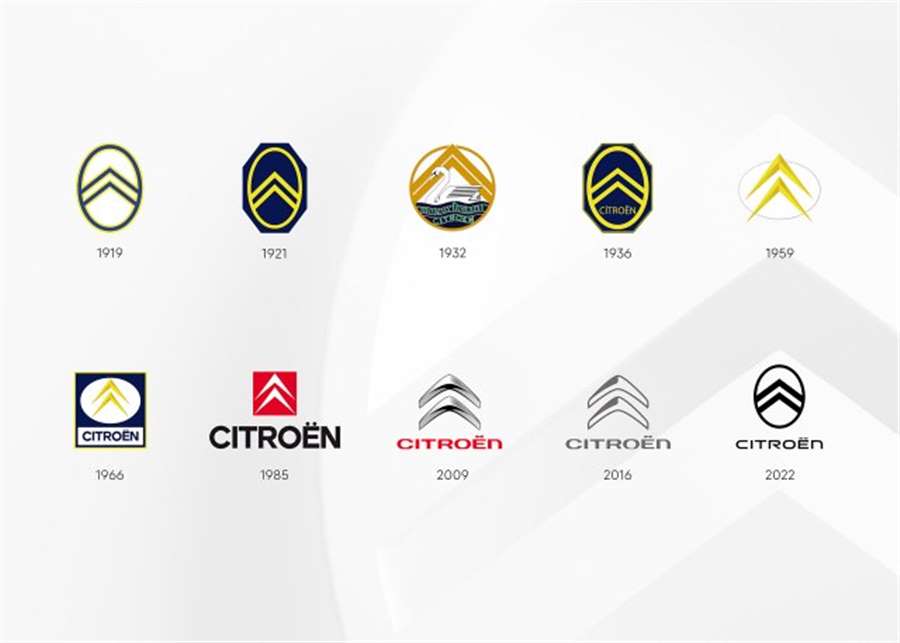
Namely, this design was chosen by founder Andre Citroen in 1919, inspired by his metalworking company that produced herringbone gear systems.
The new logo is combined with a fresh and simplified color palette and a modern font for the Citroen lettering.
In one of the different variations, the logo is painted in a "Monte Carlo Blue" shade, which will also return as an exterior color for future Citroen models.
However, Citroen is also using a brighter "Infra-Red" for physical, print and digital applications, replacing the brand's signature red.
The automaker has not yet revealed details about the upcoming concept car that will carry the new emblem.
The French company described it as "an important concept family vehicle".
{vembed Y=A__BZM1wCjM}

















